| Home | Nature Weekly Index |
2 August 2015 | Walk at the Park (Part 2) | Admiralty Park |
This is part 2 of the walk at the Admiralty Park that I shared last week.
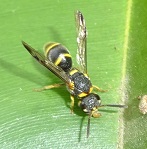
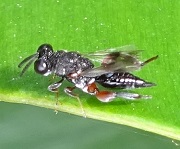
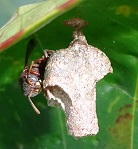 There were quite a number of solitary wasps around the area. (1) One of them had a few yellow strips across its otherwise black
body. Even the eye region had shades of yellow. This is likely to be a Stenodynerus species (Family: Vespidae). (2) The other
one was tiny wasp, around 3 millimetres in length, and with a pointed end in the abdomen. It had a pair of enlarged hind legs and
the pairs of eyes looked like that from a grasshopper. It should be a Antrocephalus species (Family: Chalcididae), a parasitic
wasp with enlarged hind legs. (3) The last one was seen on its nest that was hidden in a curled leaf of the
Sea Apple tree (Syzygium grande). Based on its head region and the nest, it might
be a paper wasp (Ropalidia species).
There were quite a number of solitary wasps around the area. (1) One of them had a few yellow strips across its otherwise black
body. Even the eye region had shades of yellow. This is likely to be a Stenodynerus species (Family: Vespidae). (2) The other
one was tiny wasp, around 3 millimetres in length, and with a pointed end in the abdomen. It had a pair of enlarged hind legs and
the pairs of eyes looked like that from a grasshopper. It should be a Antrocephalus species (Family: Chalcididae), a parasitic
wasp with enlarged hind legs. (3) The last one was seen on its nest that was hidden in a curled leaf of the
Sea Apple tree (Syzygium grande). Based on its head region and the nest, it might
be a paper wasp (Ropalidia species).
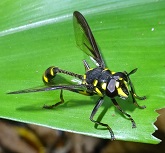
.jpg) The wasp-like insect with a long slender connection between the thorax and abdomen regions is actually a wasp-mimicking fly.
Pretending to be a wasp is a way to protect itself from predators. Its other common names are conopid fly and thick-headed fly.
This particular one might be a Physocephala species (Family: Conopidae). In general, a fly has a much larger pair of compound
eyes than a wasp. This was not the first time that I had seen this fly. I got a much better picture of one taken in another park
nearby in October 2014. In that picture, the antennae on the head region was clearly visible. It had a Y-shaped antennae that arise
from a single point from the head before splitting into 2 antennae.
The wasp-like insect with a long slender connection between the thorax and abdomen regions is actually a wasp-mimicking fly.
Pretending to be a wasp is a way to protect itself from predators. Its other common names are conopid fly and thick-headed fly.
This particular one might be a Physocephala species (Family: Conopidae). In general, a fly has a much larger pair of compound
eyes than a wasp. This was not the first time that I had seen this fly. I got a much better picture of one taken in another park
nearby in October 2014. In that picture, the antennae on the head region was clearly visible. It had a Y-shaped antennae that arise
from a single point from the head before splitting into 2 antennae.
Below were the butterflies and skippers where I managed to capture some pictures. The one noteworthy was Studded Sergeant (Athyma asura idita), which was a new addition to my butterfly picture collection, although I had already taken pictures of its caterpillar back in 2010.
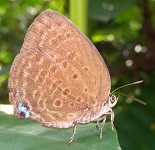
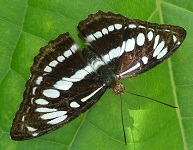

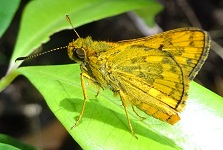
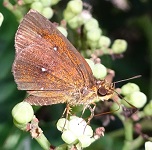
As I was working on my snail pictorial collection over the last few weeks, I was hoping to find a few nails during this walk. However, I had only encountered two, the most common Giant African Land Snail (Achatina fulica) and a small Arboreal Snail (Helicarion perfragilis). The snail panel should be ready for display this month.
Update: 19 January 2020
The wasp-like insect should be Monoceromyia javana.